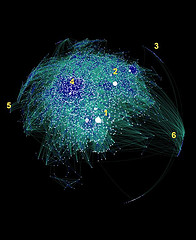 This is the first in a series of posts that will describe why we’ve built Fluidinfo and what we think it’s good for.
This is the first in a series of posts that will describe why we’ve built Fluidinfo and what we think it’s good for.
Fluidinfo exists, in part, to address an increasingly apparent mismatch. Humans are extremely social, almost inescapably social. I won’t go into evolutionary history, though. Many of us also use computers that are connected to the internet. Sitting in Barcelona, I can now connect to a machine on the other side of the world in milliseconds. We all can.
Put billions of intensely social humans in front of computers connected to a global network that ties them all together, and what do you get? Humans trying to be social using computers.
The mismatch—and the missing piece—is social data.
I don’t think we can get to truly social data while applications maintain tight control over their data. Even calling it their data is likely wrong, as much of the data ingested and stored by applications comes from users and might be in a sense owned by the user. But even that is wrong: how can you own information? You can only think you own it.
These days applications are increasingly open. But things are still far too locked down. The standard way to open one’s data today is to provide an API to let others get at it. But custom APIs are not the answer to truly social data. An API, like a user interface, only lets you do to information what the people controlling access have decided to allow you to do. You can only do what’s been anticipated. You often have to ask permission. You can’t add things to the data as you please.
Data will only be truly social when you can work with it in the kinds of ways we work with information in the real, non-computational, world. In the real world we don’t ask for permission to have an opinion on something, to add to the ball of information surrounding a concept. Our needs don’t have to be anticipated by programmers. We can share information as we please. For example, nobody owns the concept of Barcelona. If I want to essentially “tag” Barcelona as being hot, or noisy, or beautiful, I just do it. I can keep my opinion private, I can share it with certain others, I can hold conflicting opinions, I can organize things in multiple ways at the same time and give things many names.
Fluidinfo lets you do all of the above, and then some.
The main way in which it does this is by changing the control over information. In Fluidinfo, objects (which can correspond to anything – web pages, files, people, movies, ideas, etc) do not have an owner. Any application or user is free to add information to any object. There’s a strong and flexible permissions system—but permissions are applied at the level of the tags (with values) on objects, not at the level of the object itself.
The reason this is so different and much more social is that Fluidinfo gives applications and their users a world in which they can always contribute information. It can take us from a default read-only world to one in which we can all write. Without stopping to ask if it’s ok, and without anyone having to anticipate what we might one day want to do.
In a world of truly social data, any user will be able to customize or personalize anything. You’ll be able to say “I ate there” or “that’s cool” or “that sucks!” or “I know that person” or “I want one of them” or “I’ve read that” or “Hey mum, look at this” or …. or do pretty much whatever you want. I can think of hundreds of examples, making them up at will—you only have to think of the kinds of things you’re used to doing in the real world. Your contributions will be just as important as any other. You’ll be able to search based on your data, or any selection of your friends’ data. You’ll be able to combine your information with heterogeneous information created by others. You’ll be able to augment, organize, and selectively share information as you please.
The nonexistence of truly social data is the huge missing piece in the puzzle of today’s computer applications. It’s the pain we’re all feeling, but which we’re so used to that we don’t realize it. The problem won’t be solved at the level of the application. Truly social data will be the foundation of a new class of applications that all benefit by storing at least some of their information into a common social data architecture. The ones that don’t will be left behind. Because when you think about it, all data is social.
And you can guess the rest: That’s what Fluidinfo is all about. Stay tuned.




